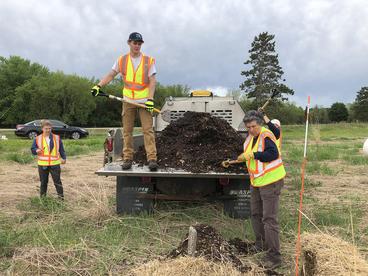Project Manager Name: Vera Krischik
Project Manager Email address: [email protected]
Project Title: Promoting conservation biocontrol of beneficial insects
Proposal ID: M.L. 2017, Chp. 96, Sec. 2, Subd. 08b

Conservation biocontrol are cultural and management methods to protect pollinators. These include modifying the habitat with stem nests to provide overwintering stems for stem nesting bees, make large mulch piles called beetle banks to provide overwintering and summer habitat for good bugs, and using insecticides that are short lived and are less harmful to bees, butterflies, and beneficial insects. Research investigated the best insecticides to conserve beneficial insects that can be used in green space.
Summary: Project Outcomes and Results
All objectives on IPM and cultural methods for conserving beneficial insects were completed. The insecticide chlorantraniliprole was toxic to butterflies and cannot be used near butterfly habitat, but is safe for bees. Pesticide residue was highest on wildflowers near potatoes and demonstrates the need for buffer strips. Download outreach/research products on this website.
Overall Project Outcome and Results
Research investigated the best insecticides to conserve beneficial insects that can be used in green space.The new bee friendly insecticide chlorotraniliprole was highly toxic to butterflies and should not be used near butterfly habitat. Chlorotraniliprole did not kill bumblebees at 4 ppm, however Monarch butterfly larvae were killed at 0.2 ppm, while Painted lady butterfly larvae were killed at 0.03 ppm and adults were killed at 0.05 ppm chlorotraniliprole. This new and highly popular bee friendly insecticide is not butterfly friendly.
In contrast, the neonicotinoid insecticide chlothianidin that was commonly used as a seed treatment and foliar applied insecticide in agriculture, is highly toxic to bees, but not butterflies. Monarch butterfly larvae were killed at 4 ppm clothianidin, while Painted lady butterfliy larvae were killed at 96 ppm clothianidin, and adults were killed at 13 ppm clothianidin. At 20 ppb clothianidin bumblebees colonies had reduced nest weight and brood production. Bumblebees are more sensitive to the neonicotinoid clothianidin (40 ppb lethal dose, 20 ppb sublethal dose) compared to two species of butterfly (4, 96 ppm lethal dose).
Pesticide residue on wild flowers near potato fields showed that 100% of 36 samples tested contained at least 2 and up to 15 different pesticides. Research on pesticide residue on flowers near corn fields showed that of 40% of 32 samples tested contained only 1 pesticide and it was atrazine. Pesticide residue was highest on wildflowers near potatoes and demonstrates the need for buffer strips.
Beetle banks are 4 ft piles of mulch that were created at 3 park sites in Washington County. At a citizen science field day,beetle banks had a mean of 131 insects compared to control plots with 1 insect. Research on reed nests as habitat for native stem nesting bees showed that there were 236 occupied reeds or 95% of the nests were occupied. Both beetle banks and stem nests increased insect abundance and are cultural methods to increase insect numbers.
Project Results Use and Dissemination
The grant produced 10 new outreach bulletins, 1 new poster, and research results which are published on this website.Our lab has provided 4 workshops/year and 28 talks/year to professionals and consumers on issues related to the grant’s research.The bulletins, poster, and research summaries were handed out at outreach events.After 2020 we will continue to use these bulletins at outreach events to educate consumers on IPM programs to protect bees, butterflies, and beneficial insects, such as the parasitoids of the emerald ash borer.
Activity 1: Conservation biocontrol in restorations, new outreach bulletins
1-1. 2020 Pollinator lawn IPM, 2 page color bulletin, by Dr. Vera Krischik, Laurie Schneider
1-2. 2020 Conservation guide: pollinators, plants, pesticides, 8 page color bulletin, by Dr. Vera Krischik, Laurie Schneider, Emily Tenczar
1-3. 2020 Best practices for pollinators: conserving biodiversity in open spaces, 2 page color bulletin, by Dr. Vera Krischik
1-4. 2020 Best practices for pollinators: conserving biodiversity in backyard landscapes, 2 page color bulletin, by Dr. Vera Krischik
1-5. 2020 Butterfly gardening, 19 page color bulletin, Dr. Vera Krischik
1-6. 2020 Conserving the endangered rusty patched bumble bee, 2 page color bulletin, by Dr. Vera Krischik,Xerces Society
1-7. 2020 Research summary: Beetle bumps
>1-8. 2020 Research summary: Pesticide residue wildflowers
Activity 2: Beneficial insect friendly pesticides that do not kill bees, new outreach bulletins
2-1. 2020 Guide to integrated pest management (IPM), 8 page color bulletin, by Dr. Vera Krischik, Laurie Schneider
2-2. 2020 Think IPM for pollinator conservation, 12x16 color poster, by Dr. Vera Krischik, Laurie Schneider
2-3. 2020 Toxicity of pesticides to pollinators, 4 pages by Dr. Vera Krischik
2-4. 2020 Protecting bees from systemic insecticides, 2 pages by Dr. Vera Krischik
2-5. 2020 SETAC research poster
2-6. 2020 Acute chronic butterfly summary
2-7. 2019 UROP research poster on neonicotinoids and birds
2-8. 2020 LCCMR graphic with results updated June